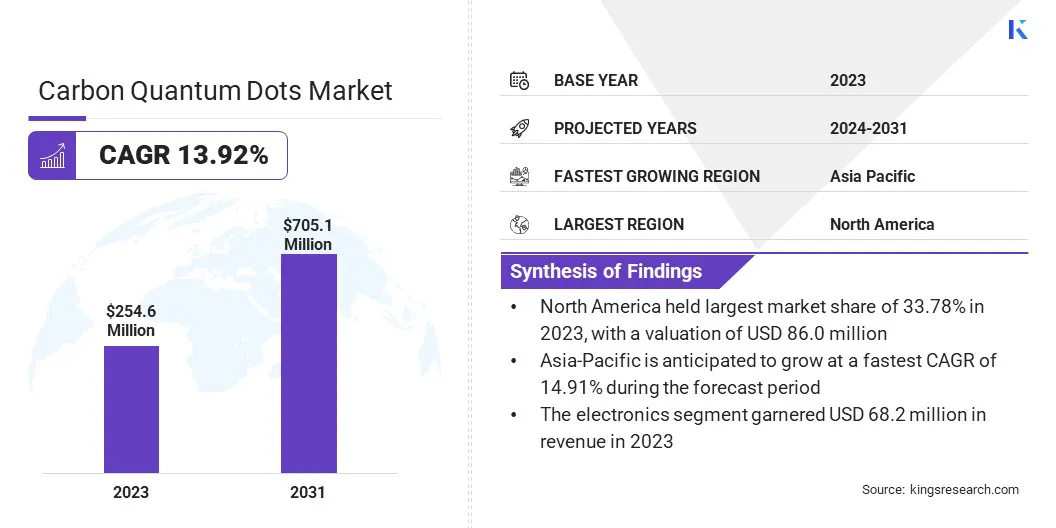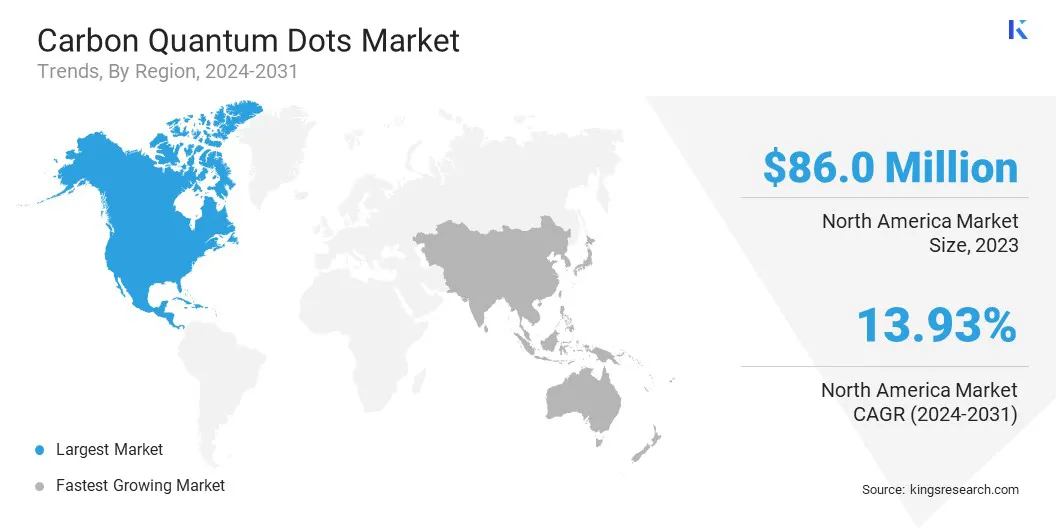Market Definition
The market refers to the industry surrounding the production and application of carbon-based nanoparticles, known for their unique optical, electrical, and chemical properties.
These dots are used in various fields, including bioimaging, sensors, drug delivery, and energy storage. The market is expanding due to their low toxicity, environmental friendliness, and versatility.
Carbon Quantum Dots Market Overview
Global carbon quantum dots market size was valued at USD 254.6 million in 2023, which is estimated to be valued at USD 283.1 million in 2024 and reach USD 705.1 million by 2031, growing at a CAGR of 13.92% from 2024 to 2031.
This growth is fueled by the increasing use of carbon quantum dots in biomedical applications, including bioimaging and drug delivery, due to their non-toxic nature, biocompatibility, and unique fluorescence properties, offering a safer alternative to traditional materials.
Major companies operating in the carbon quantum dots market are American Elements, Nanoshel LLC, QuantumDotz, Nanorh, Merck KGaA, Thermo Fisher Scientific Inc., NANOCHEMAZONE, NNCrystal US Corporation, Ocean NanoTech, Suzhou Xingshuo Nanotech Co. Ltd., and others.
The market is expanding rapidly, fueled by their diverse applications across industries such as biomedicine, energy, environmental monitoring, and electronics. CQDs are increasingly being used in bioimaging, drug delivery, sensors, and solar cells.
The market is benefiting from advancements in synthesis techniques and the growing demand for sustainable, eco-friendly materials. With ongoing research and development, CQDs are expected to be integral to next-generation technologies, broadening their market potential.
- In April 2024, a study published by the American Chemical Society explored the green synthesis of Carbon Quantum Dots (CQDs), highlighting their bioimaging potential and catalytic efficiency. CQD3-AuNPs demonstrated exceptional reduction performance, indicating promising applications in bacterial imaging and catalysis.

Key Highlights:
- The carbon quantum dots industry size was recorded at USD 254.6 million in 2023.
- The market is projected to grow at a CAGR of 13.92% from 2024 to 2031.
- North America held a share of 33.78% in 2023, valued at USD 86.0 million.
- The electronics segment garnered USD 2 million in revenue in 2023.
- Asia Pacific is anticipated to grow at a CAGR of 14.91% over the forecast period.
Market Driver
How will changing electronic and energy applications drive the market?
The growing demand for CQDs in bioimaging, LEDs, and electronics is propelling the growth of the carbon quantum dots market. CQDs offer excellent optical properties, tunability, and low-cost production, making them ideal for next-generation energy-efficient technologies.
Their ability to improve the performance and efficiency of solar cells, enhance color purity in LEDs, and enable flexible electronics is fueling widespread adoption across industries.
- In May 2024, a study from DGIST (Daegu Gyeongbuk Institute of Science and Technology) developed a pulse-type heat treatment method for PbS quantum dots, significantly enhancing solar cell efficiency by improving electrical conductivity.
Market Challenge
What negative implications would scalability limitations have on the market?
A significant challenge hindering the growth of the carbon quantum dots market is the limited scalability of production. As the demand for CQDs grows, maintaining high quality and consistency during large-scale production becomes difficult due to the complexity of synthesis methods.
To address this challenge, researchers are focusing on developing simplified, scalable synthesis techniques, such as green synthesis using renewable precursors and flow-based production methods. These approaches aim to streamline the manufacturing process, reduce costs, and ensure consistent quality, enabling large-scale commercialization.
Market Trend
What technological advancements can be seen in this market?
The carbon quantum dots market has advanced significantly due to ongoing R&D. Innovations in synthesis methods, such as improved fabrication techniques and enhanced stability, have broadened the applications of CQDs across diverse industries such as energy, electronics, and healthcare.
This has led to the increased demand for CQDs, particularly in bioimaging, sensors, and light-emitting devices. As industries adopt CQDs for their eco-friendly and cost-effective properties, the market is poised to witness strong growth.
- In August 2024, researchers from the University of Chicago’s Pritzker School of Molecular Engineering, Argonne National Laboratory, and the University of Illinois Chicago developed a method to create defect-embedded colloidal nanocrystals, offering a more efficient way to integrate quantum technologies with greater sensitivity and robustness.
Carbon Quantum Dots Market Report Snapshot
|
Segmentation
|
Details
|
|
By End-Use Industry
|
Electronics, Biomedical & Healthcare, Energy & Environment, Chemicals, Others
|
|
By Region
|
North America: U.S., Canada, Mexico
|
|
Europe: France, U.K., Spain, Germany, Italy, Russia, Rest of Europe
|
|
Asia-Pacific: China, Japan, India, Australia, ASEAN, South Korea, Rest of Asia-Pacific
|
|
Middle East & Africa: Turkey, UAE, Saudi Arabia, South Africa, Rest of Middle East & Africa
|
|
South America: Brazil, Argentina, Rest of South America
|
Market Segmentation
- By End-Use Industry (Electronics, Biomedical & Healthcare, Energy & Environment, Chemicals, and Others): The electronics segment earned USD 68.2 million in 2023, mainly due to increasing demand for carbon quantum dots in display technologies.
What is the market scenario in North America and Asia-Pacific region?
Based on region, the global market has been classified into North America, Europe, Asia Pacific, Middle East & Africa, and Latin America.

North America carbon quantum dots market captured a share of around 33.78% in 2023, valued at USD 86.0 million. This dominance is attributed to its robust technological infrastructure, high investment in R&D, and the presence of leading companies.
The regional market benefits from substantial advancements in electronics, biomedical applications, and energy sectors, supported by critical role of carbon quantum dots. Additionally, collaborations between universities, research institutes, and businesses foster continuous innovations, reinforcing North America's position as a key market.
Asia Pacific carbon quantum dots industry is poised to grow at a robust CAGR of 14.91% over the forecast period. The rapid adoption of carbon quantum dot technologies across energy, electronics, and healthcare sectors is propelling this growth.
The region's strong focus on nanotechnology research, coupled with robust manufacturing capabilities and government-backed initiatives, is further boosting this expansion. The growing demand for energy-efficient solutions, along with advancements in biomedical fields, stimulates the development and commercialization of carbon quantum dots.
- In October 2024, Samsung Display introduced a quantum dot ink recycling technology, recovering 80% of discarded QD ink. This innovative process is expected to save approximately USD 7.3 million annually.
Regulatory Frameworks
- In the U.S., the Food and Drug Administration (FDA) is responsible for protecting the public health by ensuring the safety, efficacy, and security of human and veterinary drugs, biological products, medical devices, food supply, cosmetics, and products that emit radiation . The Environmental Protection Agency (EPA) safeguards public health and the environment by mitigating significant risks, conducting research, and enforcing regulations.
- In the EU, the Regulation on the registration, evaluation, authorisation and restriction of chemicals (REACH) governs chemical safety, protecting human health and the environment from potential hazards..
Competitive Landscape
The carbon quantum dots industry is characterized by a number of participants, including both established corporations and emerging players. These companies are leveraging acquisitions to enhance technological capabilities and expand product portfolios.
These strategic acquisitions focus on securing intellectual property, accessing advanced synthesis methods, and strengthening market positions. By acquiring smaller, innovative firms, major players accelerate research and development and drive growth of the competitive quantum dot industry.
- In September 2023, Shoei Chemical acquired the quantum dot business from Nanosys, including its R&D team and assets. This strategic acquisition strengthens Shoei's position in advanced materials while Nanosys continues to innovate and deliver top-quality quantum dot technology globally.
List of Key Companies in Carbon Quantum Dots Market:


